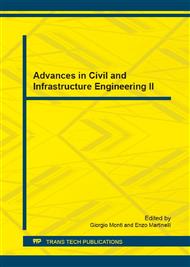[1]
Gambarelli, S., Nisticò, N., Ožbolt, J., Microplane model for concrete: Part II. Applications to CFRP-confined concrete elements, Proceedings of the 2nd International Symposium on Advances in Civil and infrastructure Engineering (ACE), Vietri sul mare, (2015).
DOI: 10.4028/www.scientific.net/amm.847.106
Google Scholar
[2]
Taylor, G.I., Plastic strains in metals, Journal of the Institute of Metals; London, 62 (1938) 307-324.
Google Scholar
[3]
Batdorf, S.B., Budianski, B., A mathematical theory of plasticity based on the concept of slip, Technical Note No. 1871, National Advisory Committee for Aeronautics, Washington, DC., (1949).
Google Scholar
[4]
Bažant, Z.P., Microplane model for strain-controlled inelastic behavior, Mechanics of engineering of materials, C.S. Desai and R. H. Gallagher, eds., John Wiley and Sons, Inc., New York, N.Y., 45-59, (1984).
Google Scholar
[5]
Bažant, Z.P., Gambarova, P.G., Crack shear in concrete: crack band microplane model, Journal of Engineering Mechanics, ASCE 110 (1984), 2015-(2035).
DOI: 10.1061/(asce)0733-9445(1984)110:9(2015)
Google Scholar
[6]
Bažant, Z.P., Oh, B. H., Microplane model for progressive fracture of concrete and rock, J. Engrg. Mech., ASCE, 111(4) (1985), 559-582.
DOI: 10.1061/(asce)0733-9399(1985)111:4(559)
Google Scholar
[7]
Bažant, Z.P., Prat, P. C., Microplane model for brittle-plastic material: parts I and II, Journal of Engineering Mechanics, ASCE, 114 (1988), 1672-1702.
DOI: 10.1061/(asce)0733-9399(1988)114:10(1689)
Google Scholar
[8]
Bažant, Z.P., Ožbolt, J., Nonlocal microplane model for fracture, damge and size effect in structures, Journal of Engineering Mechanics, ASCE 116(11) (1990), 2485-2504.
DOI: 10.1061/(asce)0733-9399(1990)116:11(2485)
Google Scholar
[9]
Carol, I., Prat, P., Bažant, Z.P., New explicit microplane model for concrete: theretical aspects and numerical implementation, International Journal of Solids and Structures 29(9) (1992), 1173-1191.
DOI: 10.1016/0020-7683(92)90141-f
Google Scholar
[10]
Bažant, Z.P., Xiang, Y., Prat, P.C., Microplane model for concrete I. Stress-strain boundaries and finite strain, Journal of Engineering Mechanics, ASCE 122(3) (1996a), 245-262.
DOI: 10.1061/(asce)0733-9399(1996)122:3(245)
Google Scholar
[11]
Bažant, Z.P., Xiang, Y., Adley, M., Prat, P.C., Akers, S., Microplane model for concrete II. Data delocalization and verification, Journal of Engineering Mechanics, ASCE 122(3) (1996b), 263-268.
DOI: 10.1061/(asce)0733-9399(1996)122:3(255)
Google Scholar
[12]
Bažant, Z.P., Carner, F.C., Carol, I., Adley, M.D., Akers, S. A, Microplane model M4 for concrete. I: formulation with work-conjugate deviatoric stress, Journal of Engineering Mechanics, ASCE, Vol. 126(9) (2000), 944-953.
DOI: 10.1061/(asce)0733-9399(2000)126:9(944)
Google Scholar
[13]
Fascetti, A., Bolander J.E., Nisticò, N., Random Lattice Modeling of Quasi-brittle Fracture in Cementitious Materials, Proceedings of the 2nd International Symposium on Advances in Civil and infrastructure Engineering (ACE), Vietri sul mare, (2015).
DOI: 10.4028/www.scientific.net/amm.847.121
Google Scholar
[14]
Ožbolt, J., Li, Y. -J. and Kožar, I., Microplane model for concrete with relaxed kinematic constraint, International Journal of Solids and Structures, 38 (2001), 2683-2711.
DOI: 10.1016/s0020-7683(00)00177-3
Google Scholar
[15]
Ožbolt, J., Bažant, Z.P., Microplane model for cyclic triaxial behavior of concrete, Journal of Engineering Mechanics, ASCE 118 (7) (1992), 1365-1386.
DOI: 10.1061/(asce)0733-9399(1992)118:7(1365)
Google Scholar
[16]
Jirásek, M., Modeling of Fracture and Damage in Quasibrittle Materials, Doctoral Dissertation, Northwestern University, (1993).
Google Scholar
[17]
Carol, I. and Bažant, Z.P., New developments in microplane and multicrack models for concrete, Fracture Mechanics of Concrete Structures, Edited by F.H. Wittman, Aedificatio Publishers, Vol. 2 (1995), 841-855.
Google Scholar
[18]
Carol, I. and Bažant, Z.P., Damage and plasticity in microplane theory, International Journal of Solids and Structures 34 (29) (1997), 3807-3835.
DOI: 10.1016/s0020-7683(96)00238-7
Google Scholar
[19]
Stroud, A.H., Approximate calculation of multiple integrals, Prentice-Hall, Inc., Englewood Cliffs, N.J., (1971).
Google Scholar
[20]
Bažant, Z.P., and Oh, B.H., Efficient numerical integration on the surface of a sphere, Zeitschrift fur Angewandte Mathematik und Mechanik 66(1) (1986), 37-49.
DOI: 10.1515/9783112547540-005
Google Scholar


